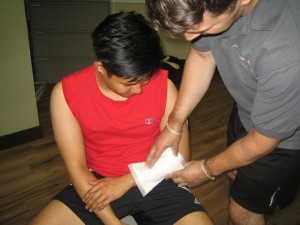Snakes are very active in the spring, early summer and fall. Most cases of snakebites occur when the weather is warm and many engage in outdoor activities. Even though most snakes are not poisonous, there are several species that are poisonous such as water moccasins, rattlesnakes, coral snakes and copperheads.
https://www.youtube.com/watch?v=_iF-ByukAf8
There are measures that can help prevent snakebites that must be taken into consideration to minimize the risk.
- Hedges and the lawn should be trimmed regularly and remove brushes from the yard. This will reduce the places where snakes like to live.
- Do not allow children to play in vacant lots that have tall weeds and grasses.
- It is recommended to use tongs when moving brush, firewood or lumber since this will securely uncover any snakes that might be hiding underneath.
- When walking through areas with tall weeds and grasses, try to poke at the ground ahead with a long pole or stick to scare snakes away.
- Wear long, loose pants and tall boots when walking or working in areas where snakes might be present.
- Do not attempt to hold snakes even if it is already dead. In case you spot a snake nearby, slowly back away from it.
- When camping outdoors, always sleep on a cot.
- You have to be aware of snakes when wading or swimming in lakes, rivers or other bodies of water.
- Learn to identify poisonous snakes and try to avoid them
Signs and symptoms of snakebites
An individual might not always know if he/she has been bitten by a snake, especially if he/she was bitten while walking through tall grass or in water. Being prepared with the steps to perform when bitten will greatly help. To learn to recognize and manage animal bites including a snake bite, sign for first aid training here. The signs and symptoms of snakebites include the following:

- Severe pain
- Two puncture marks at the bite site
- Swelling or redness around the wound
- Nausea and vomiting
- Blurred vision
- Difficulty breathing
- Tingling or numbness in the toes, fingers or area around the wound
- Fever-like symptoms such as sweating
- Fainting
- Diarrhea
- Rapid heart rate
- Convulsions
What to do for snakebites
A bite from a poisonous snake is considered as a medical emergency. If an individual has been bitten by a snake, it is important to seek help right away.
Steps when dealing with snakebites
- You have to stay calm and call for help.
- In case you are alone, try to go to the nearest hospital as soon as you can.
- Limit movement as much as possible and try to keep the wound below the level of the heart to reduce the spread of the venom.
- Remove any jewelry or tight clothing that is close to the bite site before the swelling starts.
- Try to recall the appearance of the snake such as its color, markings and shape. This will help determine the suitable treatment.
- You have to cover the bite site with dry, clean bandage.
What to avoid when dealing with snakebites
- Do not apply ice on the bite site or soak the wound in water.
- Do not cut the bite site
- Do not attempt to suck out the venom from the bite site
- Never place a tourniquet or attempt to stop the flow of blood from the bite site
- Do not pick up or trap the snake
- Do not provide the individual with caffeinated beverages such as soda or coffee after being bitten by a snake.
